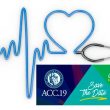Courtesy of Dr. Carlos Fava. The femoral approach is preferred when it comes to TAVR, but sometimes it is not viable. This is when other access sites come into play, such as the trans-subclavian/axillary (TS/TAx), the apical, transcaval, transcarotid (TC) or transaortic. At present, few studies have looked into this matter, which is why it...
We Must Still Fear the “Big Five Complications” After TAVR
Surgical risk scores cannot be used for transcatheter aortic valve replacement (TAVR) and they usually overestimate procedural risk. There are 5 big complications after TAVR, specifically, that cannot be predicted by conventional surgical scores. These 5 peri-procedural complications are considered important because they have a somewhat significant impact on survival after TAVR. They are: 1)...
Transcaval Access Is Safe in TAVR
Courtesy of Dr. Carlos Fava. One of the limitations to percutaneous interventions is poor or impossible femoral access. This happens especially in TAVR, with endoprosthesis or ventricular assistance devices, when the transcaval approach with cardiac occluder rises as a viable alternative. We have started to use it in TAVR, but at present there is little...
After 100,000+ Patients, TAVR Becomes the New Standard of Care
Eighty years did the trick for one the countries with more experience in transcatheter aortic valve replacement (TAVR), which made it the new “standard of care” to treat elderly patients. Following in the footsteps of pioneer Alain Cribier, Germany has led the adoption of TAVR in Europe and the rest of the world. Since 2008,...
ACC 2019 | TAVR in Bicuspids is Safe and Feasible in Real World Patients
Experts still won’t agree on whether to carry out randomized trial to put an end to this discussion, but it seems clear that balloon expandable TAVR is valid only for certain anatomies. TAVR in real world bicuspid valve populations is associated with similar outcomes at 30 days and one year when compared against cohorts...
ACC 2019 | PARTNER 3: Low Risk TAVR vs. Surgery, Fewer Events per Year
Courtesy of Dr. Carlos Fava. TAVR has largely been shown superior or non-inferior in high or intermediate risk patients. Indeed, the development of new technologies, the more simplified procedure and the increased experience of operators and team have allowed these groups to benefit from this strategy. However, there is little evidence available on low risk...
ACC 2019 | TAVR in Low-Risk Patients Is Noninferior
Courtesy of Dr. Carlos Fava. Self-expanding supraannular aortic valves have proved to be superior to surgery in high-risk patients and noninferior in intermediate-risk patients. However, the current challenge is posed by low-risk, generally younger, patients. In that sense, our purpose is to determine device effectiveness and safety in terms of mortality and stroke rates (which are...
Transcarotid Approach for Transfemoral in TAVR
Courtesy of Dr. Carlos Fava. At present, the transfemoral is the preferred access site in TAVR, for it has been shown to present fewer complications. However, whenever not feasible, we can resort to other approaches. These include the subclavian, the transapical, the transcaval, the transaortic, and the transcarotid. This last one has been studied few...
Cost-Effectiveness of TAVR in Intermediate-Risk Patients
Prior economic analyses had shown that transcatheter aortic valve replacement (TAVR) is cost-effective (which does not mean that it saves money) in high-risk patients compared with surgical replacement. In intermediate-risk patients, this equation was mere speculation until this work recently published in Circulation came along. Physicians started wondering about costs and durability after PARTNER 2 showed...
Anticoagulation Plays a Controversial Role in TAVR
Men gender, kidney failure and atrial fibrillation are the factors that most affect 3-year mortality after transcatheter aortic valve replacement. On the other hand, surprisingly enough, anticoagulation (mostly indicated for atrial fibrillation) reduces mortality risk – especially the risk of valve deterioration – after TAVR. Should anticoagulation be included in post TAVR protocols? This question...









